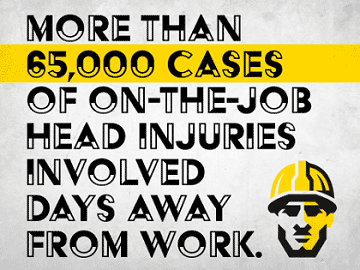- Home
- Loss Control
- Loss Control Insights
- How to Select the Right Hard Hat
Hard hats are required in many professions to protect workers’ heads. Supervisors and managers must examine these hats to make sure they balance the protection workers need with sufficient comfort so workers will wear them.
Which Type?
Occupational Safety and Health Administration (OSHA) requirements state that hard hats are needed for employees working in areas where there is a possible danger of head injury from impact, falling or flying objects, or from electrical shock and burns. American National Standards Institute (ANSI) standards divide hats into categories (Type I for top protection and Type II for both top and lateral impact) and classes (E for electrical, G for general and C for conductive). The type of hard hat your employees need depends on the dangers at your job sites. Read a summary of the OSHA regulations and updates in ANSI standards.
To choose the best hard hat for your workers, first examine potential hazards at your site. This may be relatively easy if your employees always work in the same warehouse or factory floor, but can be more difficult for contractors with shifting job sites. As you evaluate the site, you may be able to remove some potential dangers before determining which hard hat will provide the right level of protection.
If your crew moves from one job site to another, your task is tougher. Workers may be exposed to different dangers in different locations, and it may not be possible to remove hazards before your crew arrives. That means their hats must meet all possible hazards, unless you plan to swap hats as jobs change. This can be expensive and not very practical. An easier way is to opt for hats in the highest category and class your employees might require.
Protection and More
After choosing the hat category and class, consider these other features before purchasing:
- The material the hat is made of; plastic is the most common, but fiberglass may be a good choice if there are molten metals in the work area
- The weight of the shell; a lightweight shell with a low profile usually offers a better fit and more comfort
- The type of suspension, either pin-lock or ratchet; pin-lock is like a belt, while ratchet has an adjusting knob
- A suspension with multiple adjustment points (4, 6 or 8 are typical―more are better to spread out the force of an impact); adjustments also help with comfort levels
- Sweatbands or lining made of absorbent, hypoallergenic material; the band should be removable for laundering
- Venting to allow for air circulation
- Chin straps to keep the hat on if jobs require bending or running
- If employees tend to wear hats backward, choose one certified for that purpose
- Accessory slots allow workers to attach face or hearing protection
If possible, allow workers to try on sample hard hats before placing a large order so they feel comfortable with the choice.
After the Purchase
It does no good to buy the best hats if they aren’t put together correctly, worn properly or maintained. You and your employees need to know the wear-and-tear details for maximum protection.
Training is critical. EMC loss control experts who visit job sites and provide PPE training observe that many employees are not trained on how to assemble, use and adjust their hard hats.
Employees should also know how to perform daily inspections to check their hats for cracks and holes and make sure that the ratcheting works correctly.
Hard hats don’t last forever. If a hat sustains an impact, replace it immediately. Otherwise, it’s recommended that the suspension be replaced once a year, and the shell every 2 to 5 years.
Get in touch
Need help? We’re here for you! Whether you have questions or need personalized assistance, your local office is ready to support you.
Loss Control Insights
Stay informed with the latest news and receive actionable safety tips, all carefully curated by our team of experts.
